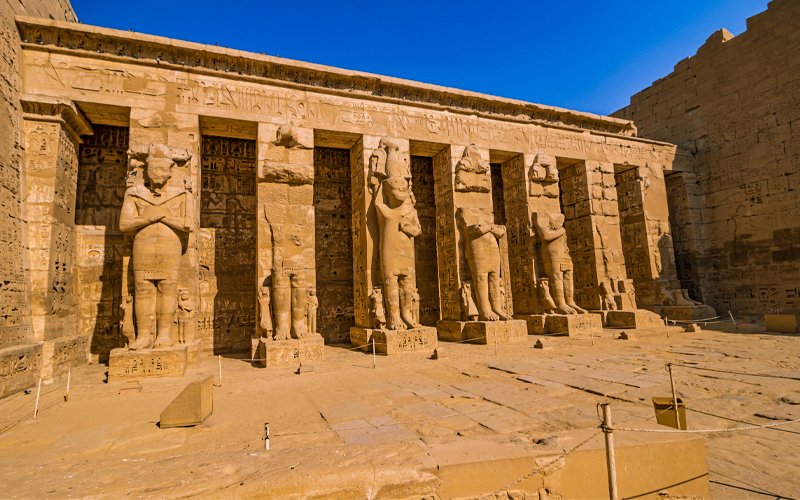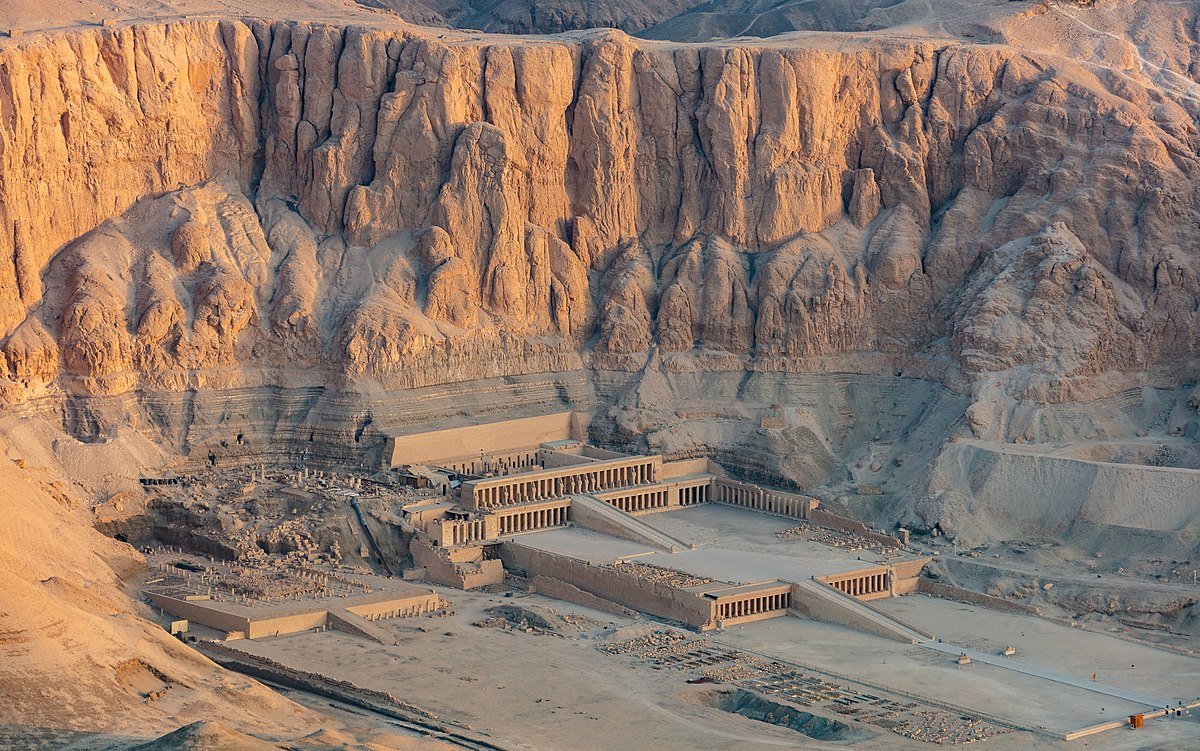In the heart of ancient Egypt, where the winds of time whisper tales of grandeur and majesty, stands the awe-inspiring Temple of Hatshepsut. This architectural marvel, nestled in the cliffs of Deir el-Bahri on the western bank of the Nile, presents itself not merely as a physical structure but as a living embodiment of a bygone era. Each limestone block meticulously placed, every intricately carved relief, and the very essence of its location tell the captivating story of a remarkable ruler, Queen Hatshepsut, who defied conventions and left an indelible mark on the annals of Egyptian history.
Unraveling the Purpose:
The big projects by Egyptian kings, like building the Temple of Hatshepsut, weren’t just to show off. They were super important for bringing the country together and making it strong. The temple, standing out among these projects, shows how everyone working together and feeling proud was a key part of the Egyptian way of keeping things balanced and working well – they called it “ma’at.” So, these buildings were not just fancy – they were like symbols of teamwork, pride, and keeping everything in harmony.
Construction and Workers:
Built during the prosperous reign of Queen Hatshepsut (1479-1458 BCE), this temple stands as a tribute to her admiration for the mortuary temple of Mentuhotep II. In a departure from tradition, skilled and unskilled Egyptian workers, rather than slaves, meticulously crafted the palaces, temples, and monuments. Their endeavors not only showcased Egypt’s prowess but also provided employment during the Nile’s inundation, fostering unity and national pride.
Hatshepsut’s Reign:
Hatshepsut, a remarkable leader, defied convention by assuming the throne in a traditionally male position. Her reign, marked by prosperity and peace, witnessed successful trade, economic growth, and ambitious public works. Notable among her accomplishments was the legendary expedition to Punt, a testament to Egypt’s wealth and Hatshepsut’s commitment to reviving the nation’s traditions. Explore also Giza Pyramid Complex.
The Temple’s Design:
Hatshepsut ordered her temple’s design to showcase her life story, with her trusted friend Senenmut crafting it to be grander than others. From the Birth Colonnade to the Punt Colonnade, each part unfolds tales of divine creation, remarkable expeditions, and the queen’s special bond with gods like Hathor and Amun. In simple terms, the temple is like a big storybook, telling about Hatshepsut’s life, adventures, and her friendship with gods, all thanks to her friend Senenmut who made it extra special.

Desecration and Legacy:
Despite Hatshepsut’s successful rule, her stepson Thutmose III erased her name from public monuments, maybe because he wanted to stick to the idea of male pharaohs. Surprisingly, the important parts of her temple were left alone. Later on, during Akhenaten’s rule, more changes were made, but it seems like he cared more about politics than religion. These actions show how people in power sometimes change the past to fit their own ideas, but Hatshepsut’s legacy remains strong, especially in the important parts of her temple that still stand today.
Rediscovery and Recognition:
Buried in historical shadows for centuries, Hatshepsut’s name resurfaced in the 19th century, thanks to scholars like Champollion. Modern discoveries and scholarly efforts have unveiled her extraordinary legacy. Her temple, Djeser-Djeseru, not only stands as an architectural marvel but also symbolizes resilience against attempts to erase her impact. Despite facing obscurity and deliberate defacement, the enduring grandeur of Hatshepsut’s temple serves as a testament to her remarkable reign. Through meticulous excavations and decoding ancient scripts, we’ve rediscovered a once-forgotten queen, unveiling a narrative that continues to shine brightly in the annals of history. Hatshepsut’s story, once hidden, now stands tall, reminding us of the indomitable spirit that prevails against the sands of time.
FAQS:
Why is the Temple of Hatshepsut significant in ancient Egyptian history?
The Temple of Hatshepsut is significant as a tribute to Queen Hatshepsut’s reign, challenging traditional gender roles. It reflects the prosperity and ambition of ancient Egypt during her rule and stands as a testament to the innovative architectural and artistic achievements of the time.
Who were the builders of the Temple of Hatshepsut?
Skilled and unskilled Egyptian workers were the builders of the Temple of Hatshepsut. Contrary to common misconceptions, there is no evidence that Hebrew slaves or any form of slave labor contributed to the construction. The temple was a result of collective Egyptian effort, showcasing the nation’s capabilities.
What stories does the design of the Temple of Hatshepsut tell?
The design of the temple is a narrative of Hatshepsut’s life and reign. From the Birth Colonnade depicting her divine creation to the Punt Colonnade detailing her glorious expedition to the mysterious ‘land of the gods,’ each element contributes to a story that intertwines her divine connections and ambitious endeavors.
Why did Thutmose III erase Hatshepsut’s name from public monuments?
Thutmose III, Hatshepsut’s stepson, erased her name from public monuments, possibly to maintain the traditional male pharaoh image and prevent the precedent of a powerful female ruler. While he removed public mentions, the inner sanctum of her temple was left largely intact, indicating a complex relationship between them.
How was the Temple of Hatshepsut rediscovered?
The temple’s existence was buried in obscurity until the 19th century. Scholars like Jean-Francois Champollion played a pivotal role in decoding hieroglyphics, leading to the rediscovery of Hatshepsut’s name and accomplishments. Modern excavations, advancements in Egyptology, and the examination of her mummy in 2006 have further contributed to the understanding of her historical significance.
Conclusion:
As we stand in the shadow of the Temple of Hatshepsut, we are not merely witnesses to an ancient structure but participants in an unfolding saga of a visionary queen who defied norms and left an indelible mark on history. The Temple of Hatshepsut stands as a testament to the enduring spirit of innovation, unity, and the pursuit of greatness that characterized this remarkable era in ancient Egypt.

